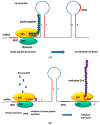Molecular Mechanisms of Drug Resistance in Staphylococcus aureus
- PMID: 35897667
- PMCID: PMC9332259
- DOI: 10.3390/ijms23158088
Molecular Mechanisms of Drug Resistance in Staphylococcus aureus
Abstract
This paper discusses the mechanisms of S. aureus drug resistance including: (1) introduction. (2) resistance to beta-lactam antibiotics, with particular emphasis on the mec genes found in the Staphylococcaceae family, the structure and occurrence of SCCmec cassettes, as well as differences in the presence of some virulence genes and its expression in major epidemiological types and clones of HA-MRSA, CA-MRSA, and LA-MRSA strains. Other mechanisms of resistance to beta-lactam antibiotics will also be discussed, such as mutations in the gdpP gene, BORSA or MODSA phenotypes, as well as resistance to ceftobiprole and ceftaroline. (3) Resistance to glycopeptides (VRSA, VISA, hVISA strains, vancomycin tolerance). (4) Resistance to oxazolidinones (mutational and enzymatic resistance to linezolid). (5) Resistance to MLS-B (macrolides, lincosamides, ketolides, and streptogramin B). (6) Aminoglycosides and spectinomicin, including resistance genes, their regulation and localization (plasmids, transposons, class I integrons, SCCmec), and types and spectrum of enzymes that inactivate aminoglycosides. (7). Fluoroquinolones (8) Tetracyclines, including the mechanisms of active protection of the drug target site and active efflux of the drug from the bacterial cell. (9) Mupirocin. (10) Fusidic acid. (11) Daptomycin. (12) Resistance to other antibiotics and chemioterapeutics (e.g., streptogramins A, quinupristin/dalfopristin, chloramphenicol, rifampicin, fosfomycin, trimethoprim) (13) Molecular epidemiology of MRSA.
Keywords: HA/CA/LA-MRSA clones; SCCmec; Staphylococcus aureus; mechanisms of drug resistance.
Conflict of interest statement
The authors declare no conflict of interest.
Figures

 , mechanisms of action—green arrows. Resistance to beta lactams: 1. Production of penicillin-binding protein PBP2A, 2. * mutations in PBP genes—rare (MODSA), 3. beta-lactamases production -usually narrow substrate spectrum. Glycopeptide resistance: 4. VanA operon (modification of the antibiotic binding site), Linezolid resistance: 5. adenylyl-N-methyltransferase Cfr-modification 23S rRNA of bacterial ribosome. Resistance to MLS-B (macrolides, lincosamides and streptogramins B): 5. Erm—erythromycin ribosome methylation. Aminoglycosides resistance: 6. antibiotics inactivation by tansferases. Fluoroinolones resistance: 7. mutations in gyrA and gyrB (topoisomerase II) and parC (grlA) and parE (topoisomerase IV) genes (modification of the antibiotic binding site), 8. removal from the bacterial cell by the efflux pump.
, mechanisms of action—green arrows. Resistance to beta lactams: 1. Production of penicillin-binding protein PBP2A, 2. * mutations in PBP genes—rare (MODSA), 3. beta-lactamases production -usually narrow substrate spectrum. Glycopeptide resistance: 4. VanA operon (modification of the antibiotic binding site), Linezolid resistance: 5. adenylyl-N-methyltransferase Cfr-modification 23S rRNA of bacterial ribosome. Resistance to MLS-B (macrolides, lincosamides and streptogramins B): 5. Erm—erythromycin ribosome methylation. Aminoglycosides resistance: 6. antibiotics inactivation by tansferases. Fluoroinolones resistance: 7. mutations in gyrA and gyrB (topoisomerase II) and parC (grlA) and parE (topoisomerase IV) genes (modification of the antibiotic binding site), 8. removal from the bacterial cell by the efflux pump.


Similar articles
-
Evaluation of the Presence and Characterization of Vancomycin-Intermediate and Heterogeneous Vancomycin-Intermediate Level Resistance Among Bloodstream Isolates of Methicillin-Resistant Staphylococcus aureus.Microb Drug Resist. 2020 Mar;26(3):238-244. doi: 10.1089/mdr.2019.0178. Epub 2019 Sep 23. Microb Drug Resist. 2020. PMID: 31545160
-
[Investigation of antibiotic resistance patterns and reduced vancomycin susceptibilities of methicillin-resistant Staphylococcus aureus isolates: a multi-center study].Mikrobiyol Bul. 2015 Apr;49(2):240-8. doi: 10.5578/mb.9230. Mikrobiyol Bul. 2015. PMID: 26167824 Turkish.
-
Activity of ceftobiprole against methicillin-resistant Staphylococcus aureus strains with reduced susceptibility to daptomycin, linezolid or vancomycin, and strains with defined SCCmec types.Int J Antimicrob Agents. 2014 Apr;43(4):323-7. doi: 10.1016/j.ijantimicag.2013.11.005. Epub 2013 Dec 11. Int J Antimicrob Agents. 2014. PMID: 24411474
-
Resistance or decreased susceptibility to glycopeptides, daptomycin, and linezolid in methicillin-resistant Staphylococcus aureus.Curr Opin Pharmacol. 2010 Oct;10(5):516-21. doi: 10.1016/j.coph.2010.06.006. Epub 2010 Jul 1. Curr Opin Pharmacol. 2010. PMID: 20598637 Review.
-
Future trends in the treatment of methicillin-resistant Staphylococcus aureus (MRSA) infection: An in-depth review of newer antibiotics active against an enduring pathogen.J Glob Antimicrob Resist. 2017 Sep;10:295-303. doi: 10.1016/j.jgar.2017.05.019. Epub 2017 Jul 18. J Glob Antimicrob Resist. 2017. PMID: 28732783 Review.
Cited by
-
Different evolution of S. aureus methicillin-resistant and methicillin-susceptible infections, Argentina.Heliyon. 2023 Nov 25;10(1):e22610. doi: 10.1016/j.heliyon.2023.e22610. eCollection 2024 Jan 15. Heliyon. 2023. PMID: 38163174 Free PMC article.
-
Kinship analysis of mecA gene of methicillin-resistant Staphylococcus aureus isolated from milk and risk factors from the farmers in Blitar, Indonesia.Vet World. 2024 Jan;17(1):216-225. doi: 10.14202/vetworld.2024.216-225. Epub 2024 Jan 25. Vet World. 2024. PMID: 38406357 Free PMC article.
-
Changes in oral, skin, and gut microbiota in children with atopic dermatitis: a case-control study.Front Microbiol. 2024 Aug 15;15:1442126. doi: 10.3389/fmicb.2024.1442126. eCollection 2024. Front Microbiol. 2024. PMID: 39211320 Free PMC article.
-
Molecular Characteristics and Antibiotic Resistance of Staphylococcus aureus Isolated from Patient and Food Samples in Shijiazhuang, China.Pathogens. 2022 Nov 11;11(11):1333. doi: 10.3390/pathogens11111333. Pathogens. 2022. PMID: 36422585 Free PMC article.
-
Synergistic combination of baicalein and rifampicin against Staphylococcus aureus biofilms.Front Microbiol. 2024 Aug 6;15:1458267. doi: 10.3389/fmicb.2024.1458267. eCollection 2024. Front Microbiol. 2024. PMID: 39165570 Free PMC article.
References
Publication types
MeSH terms
Substances
LinkOut - more resources
Full Text Sources
Medical
Molecular Biology Databases
Miscellaneous

